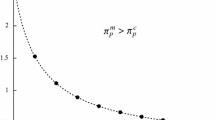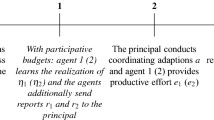Conclusions: On the optimal structure of bureaucracy
If we combine my result with those of Niskanen and Mackay/Weaver, we have three necessary conditions for interests to be mutual. First, review committees are composed of high demanders of their bureau's outputs; the committee seeks to maximize the interests of the group it represents, subject to majority approval of the full legislature. Second, the ideal point of the committee must not be ‘too extreme’ in terms of mix. Finally, the multiproduct bureau must be the least-cost institution for public supply of the services, in the sense that joint production is efficient, for the review committee interested in two or more outputs. If any of these does not hold, the interests of the bureau and its review committee diverge. The incentives for the bureau to expand across outputs without regard to efficiency means that in general we could expect the bureau to perceive the review committee as an adversary, because for the committee efficiency in production is an important consideration.
What are the implications of this result? There must exist an optimal structure for bureaucratic production of services. Further, there exist substantial incentives for discovering and implementing this structure when legislators create bureaus. Diseconomies of scope imply separate bureaus are better; economies of scope the opposite. If committees optimally structure the bureaucracy in accordance with this result, they ensure that interests do not diverge. So we see that the initial design of bureaucratic organization may be more important than was previously recognized, and calls for closer examination.
Similar content being viewed by others
References
Alchian, A. (1959). Costs and outputs. In M. Abromovitz (Ed.), Allocation of economic resources: Essays in honor of B.T. Haley. M Stanford.
Baumol, W.J. (1977). On the proper cost tests for natural monopoly in a multiproduct industry. American Economic Review, December: 809–822.
Baumol, W.J., and Braunstein, Y.M. (1971). Empirical study of scale economies and production complementarity: The case of journal publication. Journal of Political Economy, October: 1037–1049.
Denzau, A.T., and Mackay, R.J. (1980). Benefit and tax share discrimination by a monopoly bureau. Journal of Public Economics.
Mackay, R.J., and Weaver, C.L. (1979). On the mutuality of interests between bureaus and high demand review committees: A perverse result, Public Choice 34(3–4): 481–491.
Mueller, D.C. (1979). Public choice. Cambridge: Cambridge University Press.
Niskanen, W. (1971). Bureaucracy and representative government. Chicago: Aldine-Atherton.
Shen, T.Y. (1970). Economies of scale, penrose effect, growth of plants and their size distribution. Journal of Political Economy, July/August: 702–716.
Willig, R.D. (1979). Multi-product technology and market structure. American Economic Review, May: 346–351.
Author information
Authors and Affiliations
Additional information
I would like to thank Arthur Denzau, Kenneth Shepsle, and Barry Weingast for their helpful comments on earlier drafts.
Rights and permissions
About this article
Cite this article
Munger, M.C. On the mutuality of interest between bureaus and high demand review committees: The case of joint production. Public Choice 43, 211–215 (1984). https://doi.org/10.1007/BF00140835
Issue Date:
DOI: https://doi.org/10.1007/BF00140835




